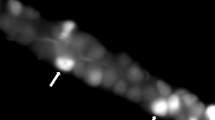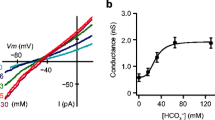Abstract
To date three potential candidates for parietal cell basolateral Cl− entry have been described: the highly 4,4′-diisothiocyanatostilbene-2,2′-disulfonic acid (DIDS)-sensitive \( {{\text{Cl}}^{{\text{ - }}} } \mathord{\left/ {\vphantom {{{\text{Cl}}^{{\text{ - }}} } {{\text{HCO}}_{{\text{3}}} ^{ - } }}} \right. \kern-\nulldelimiterspace} {{\text{HCO}}_{{\text{3}}} ^{ - } } \) exchanger AE2, the \( {\text{HCO}}_{{\text{3}}} ^{ - } \) and lowly DIDS-sensitive SLC26A7 protein, and the Na+-2Cl−K+ cotransporter (NKCC1). In this study we investigate the contribution of these pathways to secretagogue stimulated acid secretion. Individually hand-dissected rat gastric glands were microfluorimetrically monitored for Cl− influx and pHi changes. Transporter activity was determined by varying ion content and through the use of pharmacological inhibitors. Expression of SLC26A7 in rat parietal cells was shown by immunohistochemistry and Western blot. SLC26A7 was inhibited by 5-Nitro-2-(3-phenylpropyl-amino)benzoic acid (NPPB) (100 μM) in the Xenopus laevis oocyte expression system. Cl− influx in parietal cells was enhanced by histamine, depended partially on endogenous \( {\text{HCO}}_{{\text{3}}} ^{ - } \) synthesis and completely on extracellular Na+. Removal and subsequent readdition of Cl− revealed a low and a high DIDS-sensitive \( {\text{HCO}}_{{\text{3}}} ^{ - } \) extrusion system contributing to Cl− uptake. At acidic pHi, however, H+ extrusion via the H+,K+-ATPase depending on Cl− uptake was abolished only in the presence of 100 μM (NPPB) and at high (250 μM) DIDS concentration. There was no effect of the NKCC inhibitor bumetanide on stimulated H+ extrusion. These results would be compatible with SLC26A7 as a Cl− uptake system under histamine stimulation.






Similar content being viewed by others
References
Alper SL (2006) Molecular physiology of SLC4 anion exchangers. Exp Physiol 91:153–161
Ayalon A, Corcia A, Klemperer G, Caplan SR (1980) Suppression of gastric acid secretion by furosemide in isolated gastric mucosa of guinea pig. Am J Physiol 239:G532–G535
Busque SM, Kerstetter JE, Geibel JP, Insogna K (2005) l-type amino acids stimulate gastric acid secretion by activation of the calcium-sensing receptor in parietal cells. Am J Physiol 289:G664–G669
Cheng I, Qureshi I, Chattopadhyay N, Qureshi A, Butters RR, Hall AE, Cima RR, Rogers KV, Hebert SC, Geibel JP, Brown EM, Soybel DI (1999) Expression of an extracellular calcium-sensing receptor in rat stomach. Gastroenterology 116:118–126
Dudas PL, Mentone S, Greineder CF, Biemesderfer D, Aronson PS (2006) Immunolocalization of anion transporter Slc26a7 in mouse kidney. Am J Physiol Renal Physiol 290:937–945
Flagella M, Clarke LL, Miller ML, Erway LC, Giannella RA, Andringa A, Gawenis LR, Kramer J, Duffy JJ, Doetschman T, Lorenz JN, Yamoah EN, Cardell EL, Shull GE (1999) Mice lacking the basolateral Na-K-2Cl cotransporter have impaired epithelial chloride secretion and are profoundly deaf. J Biol Chem 274:26946–26955
Gawenis LR, Ledoussal C, Judd LM, Prasad V, Alper SL, Stuart-Tilley A, Woo AL, Grisham C, Sanford LP, Doetschman T, Miller ML, Shull GE (2004) Mice with a targeted disruption of the AE2 Cl-/HCO3-exchanger are achlorhydric. J Biol Chem 279:30531–30539
Geibel JP, Wagner CA, Caroppo R, Qureshi I, Gloeckner J, Manuelidis L, Kirchhoff P, Radebold K (2001) The stomach divalent ion-sensing receptor SCAR is a modulator of gastric acid secretion. J Biol Chem 276:39549–39552
Grahammer F, Herling AW, Lang HJ, Schmitt-Graff A, Wittekindt OH, Nitschke R, Bleich M, Barhanin J, Warth R (2001) The cardiac K+ channel KCNQ1 is essential for gastric acid secretion. Gastroenterology 120:1363–1371
Haas M, Forbush B (2000) The Na-K-Cl cotransporter of secretory epithelia. Annu Rev Physiol 62:515–534
Hersey SJ, Sachs G (1995) Gastric-acid secretion. Physiol Rev 75:155–189
Hirschowitz BI, Keeling D, Lewin M, Okabe S, Parsons M, Sewing K, Wallmark B, Sachs G (1995) Pharmacological aspects of acid secretion. Digest Dis Sci 40:S3–S23
Jons T, Warrings B, Jons A, Drenckhahn D (1994) Basolateral localization of anion exchanger 2 (AE2) and actin in acid-secreting (parietal) cells of the human stomach. Histochemistry 102:255–263
Kim KH, Shcheynikov N, Wang Y, Muallem S (2005) SLC26A7 is a Cl− channel regulated by intracellular pH. J Biol Chem 280:6463–6470
Kirchhoff P, Andersson K, Socrates T, Sidani S, Kosiek O, Geibel J (2006) Characteristics of the K+-competitive H,K-ATPase inhibitor AZD0865 in isolated rat gastric glands. Am J Physiol 291:G838–G843
Lytle C, Xu JC, Biemesderfer D, Forbush B (1995) Distribution and diversity of Na-K-Cl cotransport proteins: a study with monoclonal antibodies. Am J Physiol 38:C1496–C1505
McDaniel N, Lytle C (1999) Parietal cells express high levels of Na-K-2Cl cotransporter on migrating into the gastric gland neck. Am J Physiol 276:G1273–G1278
McDaniel N, Pace AJ, Spiegel S, Engelhardt R, Koller BH, Seidler U, Lytle C (2005) Role of Na-K-2Cl cotransporter-1 in gastric secretion of nonacidic fluid and pepsinogen. Am J Physiol 289:G550–G560
Muallem S, Burnham C, Blissard D, Berglindh T, Sachs G (1985) Electrolyte transport across the basolateral membrane of the parietal cells. J Biol Chem 260:6641–6653
Orloff SL, Bunnett NW, Walsh JH, Debas HT (1992) Intestinal acid inhibits gastric-acid secretion by neural and hormonal mechanisms in rats. Am J Physiol 262:G165–G170
Paradiso AM, Townsley MC, Wenzl E, Machen TE (1989) Regulation of intracellular pH in resting and in stimulated parietal cells. Am J Physiol 257:C554–C561
Paradiso AM, Tsien RY, Demarest JR, Machen TE (1987) Na–H and Cl-HCO3 exchange in rabbit oxyntic cells using fluorescence microscopy. Am J Physiol 253:C30–C36
Petrovic S, Ju X, Barone S, Seidler U, Alper SL, Lohi H, Kere J, Soleimani M (2003) Identification of a basolateral Cl-/HCO3-exchanger specific to gastric parietal cells. Am J Physiol 284:G1093–G1103
Petrovic S, Ma L, Wang Z, Soleimani M (2003) Identification of an apical Cl-/HCO-3 exchanger in rat kidney proximal tubule. Am J Physiol 285:C608–C617
Prinz C, Kajimura M, Scott D, Helander H, Shin JM, Besancon M, Bamberg K, Hersey S, Sachs G (1992) Acid secretion and the H,K-Atpase of stomach. Yale J Biol Med 65:577–596
Radebold K, Horakova E, Gloeckner J, Ortega G, Spray DC, Vieweger H, Siebert K, Manuelidis L, Geibel JP (2001) Gap junctional channels regulate acid secretion in the mammalian gastric gland. J Membr Biol 183:147–153
Rossmann H, Bachmann O, Wang Z, Shull GE, Obermaier B, Stuart-Tilley A, Alper SL, Seidler U (2001) Differential expression and regulation of AE2 anion exchanger subtypes in rabbit parietal and mucous cells. J Physiol (Lond) 534:837–848
Samuelson LC, Hinkle KL (2003) Insights into the regulation of gastric acid secretion through analysis of genetically engineered mice. Ann Rev Physiol 65:383–400
Seidler U, Hubner M, Roithmaier S, Classen M (1994) pHi and \( {\text{HCO}}_{{\text{3}}} ^{ - } \) Dependence of proton extrusion and Cl- base exchange rates in isolated rabbit parietal cells. Am J Physiol 266:G759–G766
Singh SK, Binder HJ, Geibel JP, Boron WF (1995) An apical permeability barrier to NH3/NH4+ in isolated, perfused colonic crypts. Proc Natl Acad Sci USA 92:11573–11577
Soybel DI, Gullans SR, Maxwell F, Delpire E (1995) Role of basolateral Na+-K+-Cl- cotransport in HCl secretion by amphibian gastric mucosa. Am J Physiol 38:C242–C249
Stuart-Tilley A, Sardet C, Pouyssegur J, Schwartz MA, Brown D, Alper SL (1994) Immunolocalization of anion exchanger AE2 and cation exchanger NHE-1 in distinct adjacent cells of gastric mucosa. Am J Physiol 266:C559–C568
Thomas HA, Machen TE (1991) Regulation of Cl/HCO3 exchange in gastric parietal cells. Cell Regul 2:727–737
Waisbren SJ, Geibel J, Boron WF, Modlin IM (1994) Luminal perfusion of isolated gastric glands. Am J Physiol 266:C1013–C1027
Yao X, Forte JG (2003) Cell biology of acid secretion by the parietal cell. Annu Rev Physiol 65:103–131
Acknowledgments
This work was supported by grants from: NIH DK50230 (to J Geibel), DE12309 (to S Muallem), and the Swiss national science foundation PBZHB-110427 (to P Kirchhoff). We cordially thank Paul L. Dudas, Peter Aronson, and SueAnn Mentone for their technical help and support with the immunoblotting techniques.
Author information
Authors and Affiliations
Corresponding author
Additional information
O. Kosiek and Stephanie M. Busque contributed equally to this study and therefore share first authorship.
Rights and permissions
About this article
Cite this article
Kosiek, O., Busque, S.M., Föller, M. et al. SLC26A7 Can function as a chloride-loading mechanism in parietal cells. Pflugers Arch - Eur J Physiol 454, 989–998 (2007). https://doi.org/10.1007/s00424-007-0254-y
Received:
Revised:
Accepted:
Published:
Issue Date:
DOI: https://doi.org/10.1007/s00424-007-0254-y




